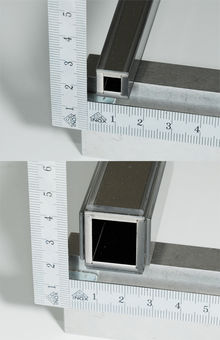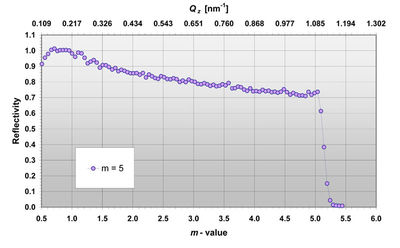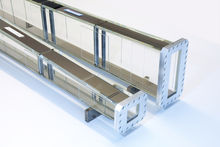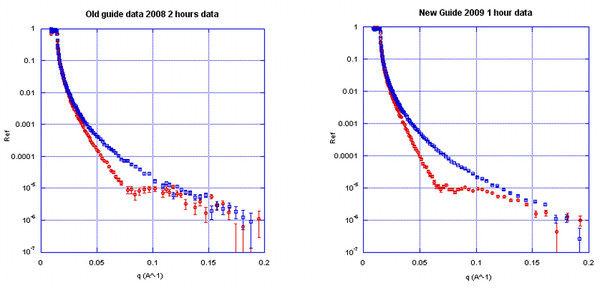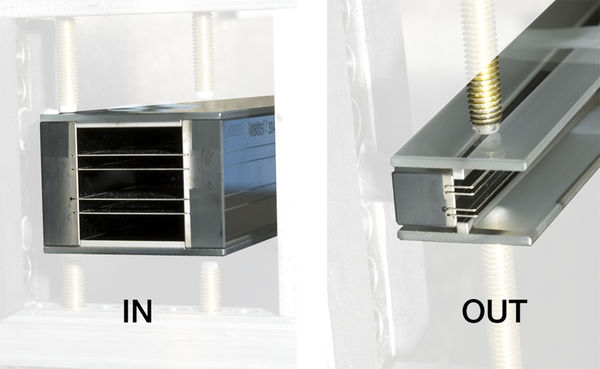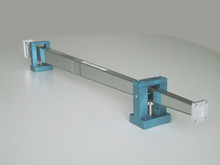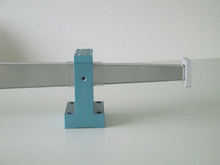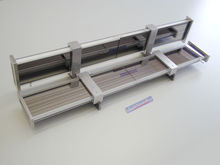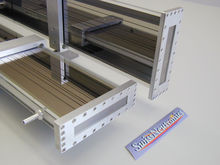focusing devices
non-linear tapered neutron optic - TOPAZ, SNS
The non-linear tapered guide for the beamline TOPAZ is the first neutron optics with supermirror coatings m = 5. The highly sophisticated coating technology of SwissNeutronics enabled for an excellent performance with reflectivities between 68 and 72% at the critical edge of the supermirror measured on all substrates. The non-linear tapered guide profile was developed by the customer and realized with the “truly curved” concept (continuous curvature) by SwissNeutronics.
- type: non-linear focusing guide optics
- path/profile: customized non-linear profile
- cross-section: 15.37 × 17.74mm² → 6.06 × 6.06mm²
- length: 937mm
- coating: Ni/Ti, m = 5
- substrate: Borofloat
- waviness of truly curved profile < ≈10-4 rad
- pronounced beam focusing
parabolic guide optics – D17, ILL
The D17 reflectometer uses a high resolution in the horizontal plane to probe thin films. However, in the vertical direction the divergence of the neutron beam can be large in order to increase the intensity, in particular for small samples. Therefore a vertical focusing neutron optics was desired utilizing a truly curved parabolic profile with high m = 4 supermirror coating (R ≈ 0.80). At the same instance the device should provide a pre-collimation in the horizontal plane. For this purpose the side walls are straight and equipped with B4C baffles.
After installation, first tests on a standard sample confirm that the neutron flux at the sample is improved by more than a factor of 2. For smaller samples the gain will be even higher compared to the simple geometrical confinement of the probing beam due to sample size and/or beam defining apertures.
- type: vertical parabolic focusing guide optics
- path/profile: vertical truly curved parabolic / horizontal collimator
- height of guide: 150.00mm → 46.19mm
- length: 3300mm
- coating: Ni/Ti, m = 4
- substrate: Borofloat
- waviness of truly curved parabolic profile ≈0.6 × 10-4 rad
- B4C blades are integrated into the sides to collimate the beam in the horizontal plane
parabolic multi-channel guide – StressSpec, FRM-II
An optimized multi-channel parabolic guide focuses the neutron beam coming from the monochromator of the instrument StressSpec (FRM-II) to a small spot on the samples. The pictures below show the thin glass plates at the entrance and exit of the device. The narrow nose-pieces of the top/bottom plates at the exit have a width of only 2mm.
- type: vertical parabolic focusing with sub-division into 5 channels
- path/profile: vertical truly curved parabolic / horizontal linear tapering
- cross-section outer guide: 30.00 × 30.00mm² → 2.00 × 5.89mm²
- cross-section midmost channel: 30.00 × 7.50mm² → 2.00 × 2.36mm²
- length: 1000mm
- coating: Ni/Ti, m = 3
- substrate: Borofloat
- waviness of truly curved parabolic profile ≈1 × 10-4 rad
- The sides are coated with neutron absorbing material for beam collimation
parabolic guide optics - HQR, JRR-3M
The high resolution triple-axis spectrometer (JRR-3M) uses a double focusing parabolic guide optics to enhance the neutron intensity available for experiments. The device is optimized with a focal length of 290mm in the horizontal plane and 92mm in the vertical plane from the exit of the guide. The supermirror coating with m = 3 and high reflectivity (R > 0.85) enables efficient beam focusing.
- type: parabolic focusing guide optics
- path/profile: truly curved parabolic
- cross-section: 21.07 × 54.85mm² → 10 × 16mm²
- length: 1000mm
- coating: Ni/Ti, m = 3
- substrate: Borofloat
- waviness of truly curved parabolic profile < ≈10-4 rad
- pronounced beam focusing
This optics focuses in the vertical and horizontal plane. The vertical focusing is optimized by sub-dividing the guide height into 9 channels with parabolic profiles. The horizontal focusing needs to be only moderate, thus it is sufficient to use a linear tapering.
- type: multi-channel parabolic optics – 9 channels
- path/profile: truly curved parabolic, linear tapering
- cross-section: 20 × 90mm² → 12 × 52mm²
- length: 1.8 m
- coating: Ni/Ti, m = 3, 3.6
- substrate: float glass, Borofloat
- pronounced beam focusing
The Prompt Gamma Activation Analysis station at the FRM-II utilizes an elliptic neutron guide which is attached to the preceding conventional neutron guide. Simulations of the instrument group established that a elliptic neutron guide provides best focusing properties. The last section (≈ 1 m) is mounted on an optional support, which has highly repeatable positioning. Thus a simple change between two different beam sizes is possible.
- type: elliptic neutron guide
- path/profile: truly curved elliptic
- cross-section: 50 × 110mm² → 8.42 × 18.55mm²
- length: 7090mm
- coating: Ni/Ti m = 3
- substrate: float glass

